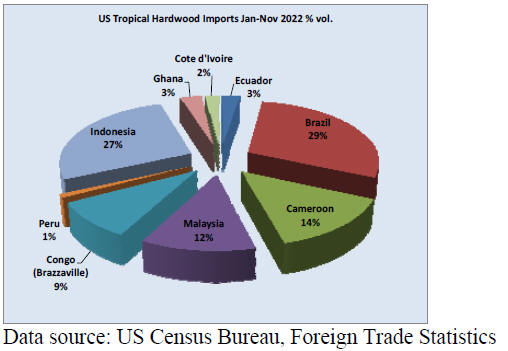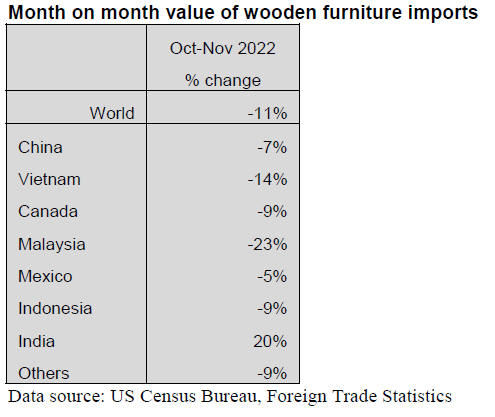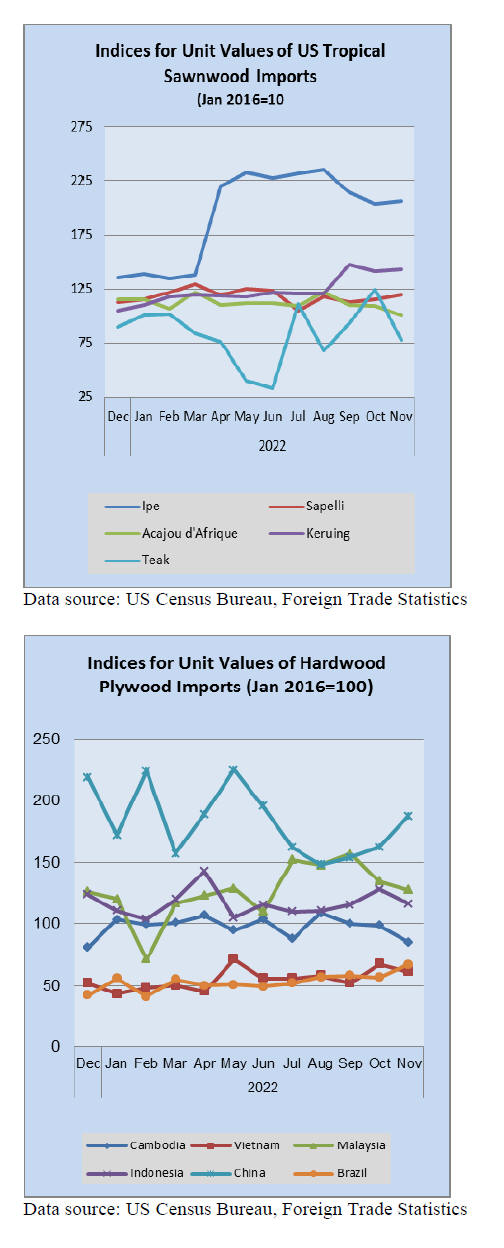|
Report from
North America
Tropical hardwood imports dip
US imports of sawn tropical hardwood fell 10% in
November. The 18,578 cubic metres imported was the
lowest monthly total of the year except for August.
Volume of the most-imported woods all declined as
imports of Ipe fell 12%, Sapelli dropped 19%, and
Keruing plunged 52%.
Imports of Mahogany and Balsa both showed impressive
gains over October’s numbers. Imports were down for the
month from most trading partners yet imports from
Cameroon rose 38% and imports from Ecuador rose 68%
to both reach their strongest month of the year.
While direct year to year comparisons are difficult due to
changes in measurements by the US Department of
Agriculture, the total volume of sawn tropical hardwood
imported into the US in 2022 through November appears
to already be more than double that for all of 2021.

Hardwood plywood imports fall 21%
US imports of hardwood plywood declined by 21% in
November, falling to their lowest level since January
2021. The 220,249 cubic metres imported was 22.5% less
than that of November 2021.
Imports from Russia, which inexplicably inflated in
October, crashed in November falling 90% to their lowest
level in nearly 12 years. Imports from Malaysia,
Cambodia, China and Vietnam also fell sharply.
Despite the declines, total imports from nearly all trading
partners remain ahead of 2021 totals through November.
Total US imports of hardwood plywood are up 14% over
last year through November.

Veneer imports gain
US imports of tropical hardwood rose 9% in November as
imports from Africa soared. Imports from Cameroon rose
695% in November to an all-time record level while
imports from Cote d’Ivoire doubled to reach their highest
level since September 2018. These gains more than offset
sharp declines in imports from China and India.
Total imports for November were 65% higher than the
previous November while year to date imports are up 55%
over 2021. Imports from all major trading partners are
well ahead of 2021 year to date through November.
Hardwood flooring imports decline
US imports of hardwood flooring fell by 24% in
November to a level 27% less than that of November
2021. Imports from Brazil declined 66% while imports
from Malaysia slid 23%.
Imports from Indonesia continued their recent gains, rising
33% to top US$1 million for the first time since 2016.
Imports from Indonesia are nearly tripling 2021 totals year
to date through November. Despite the poor November
numbers, total imports of hardwood flooring remain ahead
of 2021 year to date, but now by only 8%.
Imports of assembled flooring panels continued to slide in
November, falling 3% from October to a level 17% lower
than that of last November. Imports from Brazil nearly
disappeared, falling 98%, while imports from Thailand
also fell sharply for the second straight month. Despite the
decline, total imports of assembled flooring panels year to
date are ahead of 2021 by 26% through November.
Moulding imports fall slightly while imports from China rebounded
While US imports of hardwood moulding decreased in
November by 4%, the month was still 21% better than the
previous November.
Imports from China, which dropped sharply in October,
rebounded in November gaining 99% while imports from
Brazil showed a 27% increase. Imports from Brazil are
ahead 81% year to date over 2021 through November.
Total US imports of hardwood moulding are up 25% year
to date.
Wooden furniture imports fall in November
US imports of wooden furniture fell again in November,
declining for the fifth time in the last six months. At
US$1.80 billion, November imports were 11% below that
of October, but were 8% higher than that of November
2021. Imports from most suppliers were down, with
imports from Malaysia (down 23%) and Vietnam (down
14%) declining the most. With the exception of China,
imports from most countries remain up more than 10%
over 2021 year to date. Total wooden furniture imports
are ahead of 2021 by 7% year to date through November.
Meanwhile, residential furniture orders continued to
plummet, falling 30% in October 2022 from the same
month in 2021, according to Smith Leonard’s latest
Furniture Insights survey. Year to date, orders are down
29%. These declines were seen for nearly all survey
respondents—88% reported a decline in orders for the
month, while 91% reported a decline for the year.
Smith Leonard’s Ken Smith wrote that he’s concerned
with receivable levels, as many dealers are seeing big
slowdowns at retail. Inventories were flat from September
but up 47% from last year.
“We knew that the good business in late 2020 and 2021
would not continue,” said Smith. “As the slowdown
happened, the results have been a bit harsh as to how slow
it has become. Maybe it does not feel so bad for some
since backlogs were built so high, (as) production and
shipping have been able to keep things moving, but it is
beginning to feel not so good as backlogs have declined
significantly for so many.”
See:https://www.furnituretoday.com/financial/furnitureorders-fall-30-in-october-has-the-recession-begun/

US furniture industry faced multiple problems in 2022
Furniture retailers and suppliers alike saw big swings in
supply and demand throughout 2022, making it difficult to
properly adjust. Much of the turmoil was a result of the
waning COVID pandemic.
Here are five of the biggest problems the industry faced
over the year according to Furniture Today:
Ocean container rates -- Perhaps the most infamous issue
during the latter half of the pandemic was soaring
container rates, which saw unprecedented rises. In
September 2021, average spot rates reached their peak at
US$10,377 per 40-foot container according to Drewry
World Container Index. That number is nearly 10 times
higher than pre-pandemic 2019’s average of US$1,420.
Low demand -- The home furnishings industry saw record
demand in 2021 and the first quarter or so of 2022, before
the faucet was shut off with a thud. Inflation then reared
its head, along with a slowing of the overall economy,
soaring gas prices and more. Since then, the industry has
been in steady decline. Manufacturing orders have dipped
every month since May and show no signs of ceasing that
pattern any time soon.
Labour -- The labour shortage – particularly for domestic
manufacturers – has been a problem affecting the industry
for some time. It hasn’t shown much of an improvement
this year.
Inland freight -- Domestic manufacturers and importers
alike struggled more with inland freight and trucking,
especially in the latter half of the year.
“Inland freight is awful,” said Rusty Morris, vice president
of sales and marketing at American Woodcrafters, which
imports from Indonesia. “Pricing is ridiculous. Fuel and
labor costs are up. It’s making it difficult to hit our
strategy of expanding west of the Mississippi.”
The issue, at least on the price side, may be improving.
Transportation capacity rose in November, pushing prices
downward at their fastest rate on record.
Inventory -- Through most of 2021, retailers were buying
what they could simply to have available product, due to
supply delays and disruptions. As 2022 hit, supply
improved and demand lessened, and many retailers found
themselves with a glut of product. Inventory still sits high
for many as 2023 comes into the fold, but the situation
may be improving.
See:https://www.furnituretoday.com/industry-issue/the-top-5-issues-affecting-the-furniture-industry-in-2022/
Housing tough time ahead for builders
According to experts interviewed by US News and World
Report, several factors may make building a house or
buying a new construction home more expensive – or
harder to find – in 2023.
The biggest obstacle for homebuilding in 2023 is the more
pessimistic outlook coming from builders themselves –
and it’s been low for some time. “Homebuilder sentiment
has been down in every month of 2022,” says Orphe
Divounguy, senior economist for Zillow.
The continued decline in builder confidence and
subsequent builder slowdown means catching up on the
millions of housing units the US needs is further in the
distance. This means a continued housing shortage that
will keep prices higher.
Further, the rise in interest rates, combined with already
sky-high home prices, has led to many buyers opting to
hold off on shopping for a home. “The buyer’s purchasing
power has decreased 25% to 30%, … and that rapid
decrease (in affordability), or increase in interest rates, has
caused … a disruption in the housing market,” says Noah
Breakstone, CEO of BTI Partners, a Florida real estate and
land developer.
On the positive side, structural lumber is significantly
cheaper than it was in 2021 – less than one-third the price
in December 2022 compared to December 2021,
according to Trading Economics. Other construction
materials, from concrete to ceramic tile and asphalt
roofing, have all risen moderately since 2021. Also,
properties planned, permitted and sold months prior are
still being delivered as completed houses, and the rate at
the end of 2022 shows growth compared to the same time
in 2021, when materials availability and supply chain
issues were more exacerbated.
See:
https://www.forbes.com/sites/brendarichardson/2022/12/19/experts-predict-what-the-housing-market-will-look-like-in-2023/?sh=596a08eabfc0

Disclaimer: Though efforts have been made to ensure
prices are accurate, these are published as a guide only.
ITTO does not take responsibility for the accuracy of this
information.
The views and opinions expressed herein are those of
the correspondents and do not necessarily reflect those
of ITTO
|